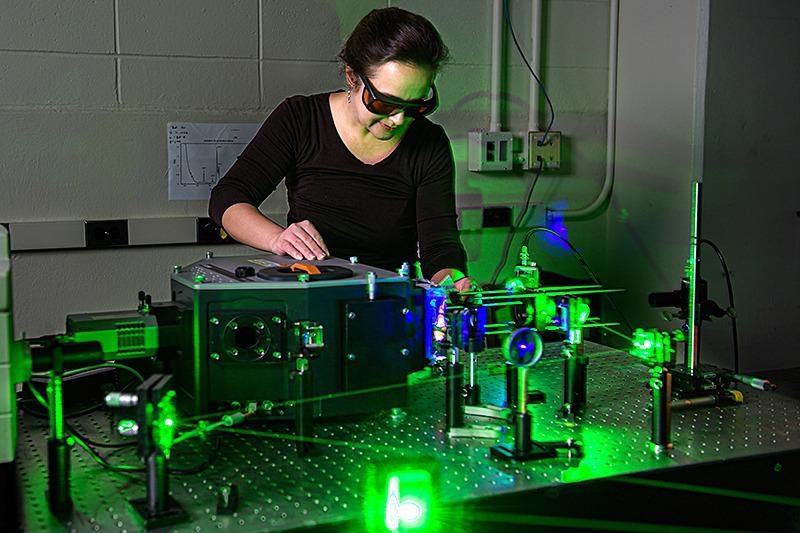Jun 16 2021
Human beings can do numerous things that cannot be performed by plants. They can walk around, hear, talk, see and touch. However, plants have one significant advantage over human beings: they can produce energy directly from the sun.
 Yulia Pushkar, a Purdue biophysicist, is working to decipher photosynthesis to unlock the possibilities of artificial photosynthesis as a reliable, clean energy source. Image Credit: Purdue Univeristy/Rebecca McElhoe.
Yulia Pushkar, a Purdue biophysicist, is working to decipher photosynthesis to unlock the possibilities of artificial photosynthesis as a reliable, clean energy source. Image Credit: Purdue Univeristy/Rebecca McElhoe.
This process of converting solar light directly into usable energy, known as photosynthesis, may soon become an achievement that can be mimicked by humans to harness solar energy for storable, clean and efficient fuel. If this becomes a reality, it could potentially pave the way to clean energy. Sufficient energy hits the earth in the form of solar light in one hour to fulfill all the energy requirements of human civilization for a whole year.
Yulia Pushkar, a biophysicist and professor of physics in Purdue’s College of Science, may have a method to harness that energy by imitating plants.
Solar power and wind power, harnessed by photovoltaic cells, are the two main forms of clean energy available. The addition of a third — that is, synthetic photosynthesis — would considerably alter the landscape of renewable energy. The potential to preserve the energy easily, without needing large batteries, would considerably enhance the ability of humans to power society in a clean and efficient manner.
Both photovoltaics and wind turbines have drawbacks in terms of complicating factors and environmental impacts. Pushkar believes that artificial photosynthesis may have the potential to overcome these pitfalls.
We and other researchers around the world are working incredibly hard to try to come up with accessible energy. Energy that is clean and sustainable that we can create with nontoxic, easily available elements. Our artificial photosynthesis is the way forward.
Yulia Pushkar, Biophysicist and Professor of Physics, College of Science, Purdue University
Photosynthesis is an intricate web of processes in which plants transform the water molecules and radiance of the sun into usable energy in the form of glucose. To perform this, plants use a pigment, generally the well-known chlorophyll, as well as metals, enzymes, and proteins.
Photovoltaic technology is the closest process to artificial photosynthesis humans have today. In this technology, a solar cell changes solar energy into electricity. But this process is known to be inefficient and only captures around 20% of solar energy. On the other hand, photosynthesis is radically more efficient and can store 60% of solar energy in the form of chemical energy in associated biomolecules.
The efficiency of solar panels, which are simple photovoltaic cells, is restricted by the potential of semiconductors to absorb light energy and by the ability of the cell to generate power. That limitation is something that could be surpassed by scientists through synthetic photosynthesis.
With artificial photosynthesis, there are no fundamental physical limitations. You can very easily imagine a system that is 60% efficient because we already have a precedent in natural photosynthesis. And if we get very ambitious, we could even envision a system of up to 80% efficiency.
Yulia Pushkar, Biophysicist and Professor of Physics, College of Science, Purdue University
Pushkar added, “Photosynthesis is massively efficient when it comes to splitting water, the first step of artificial photosynthesis. Photosystems II proteins in plants do this a thousand times a second. Blink, and it’s done.”
Pushkar’s team is simulating the process by constructing their own artificial leaf analog that absorbs light and breaks down water molecules to produce hydrogen. Hydrogen can be utilized as a fuel by itself through fuel cells or can be added to other fuels, like natural gas, or integrated into fuel cells to power everything from houses and vehicles to hospitals, laboratories and small electronic devices.
Pushkar's new findings, which provide a better insight into the way water molecules split at the time of photosynthesis, were recently reported in the journal, Chem Catalysis: Cell Press.
Researchers in Pushkar’s laboratory tested combinations of natural photosystem II proteins and synthetic catalysts in an effort to figure out what works best and why. Pushkar also prioritizes the use of chemicals and compounds that can be easily accessed, are readily abundant on Earth and are non-toxic to the planet.
However, advances in artificial photosynthesis are quite complicated considering that photosynthesis is highly multifaceted — a fact bemoaned by biochemistry students everywhere.
The reaction is very complex. The chemistry of splitting water molecules is extremely intricate and difficult.
Yulia Pushkar, Biophysicist and Professor of Physics, College of Science, Purdue University
Since the 1970s, investigators have been working on artificial photosynthesis. That is certainly a long time, but not when one remembers that photosynthesis took millions of years to emerge. Scientists also think that unlike flight, intelligence, or communication, photosynthesis has evolved just once — around three billion years ago, only about 1.5 billion years into Earth’s existence.
Pushkar believes that sufficient progress would be made in the next 10 to15 years and this will drive commercially available artificial photosynthesis systems to appear online. Pushkar’s study was financially supported by the National Science Foundation.
Journal Reference:
Ezhov, R., et al. (2021) Do multinuclear 3d metal catalysts achieve O–O bond formation via radical coupling or via water nucleophilic attack? WNA leads the way in [Co4O4]n+. Chem Catalysis. doi.org/10.1016/j.checat.2021.03.013.